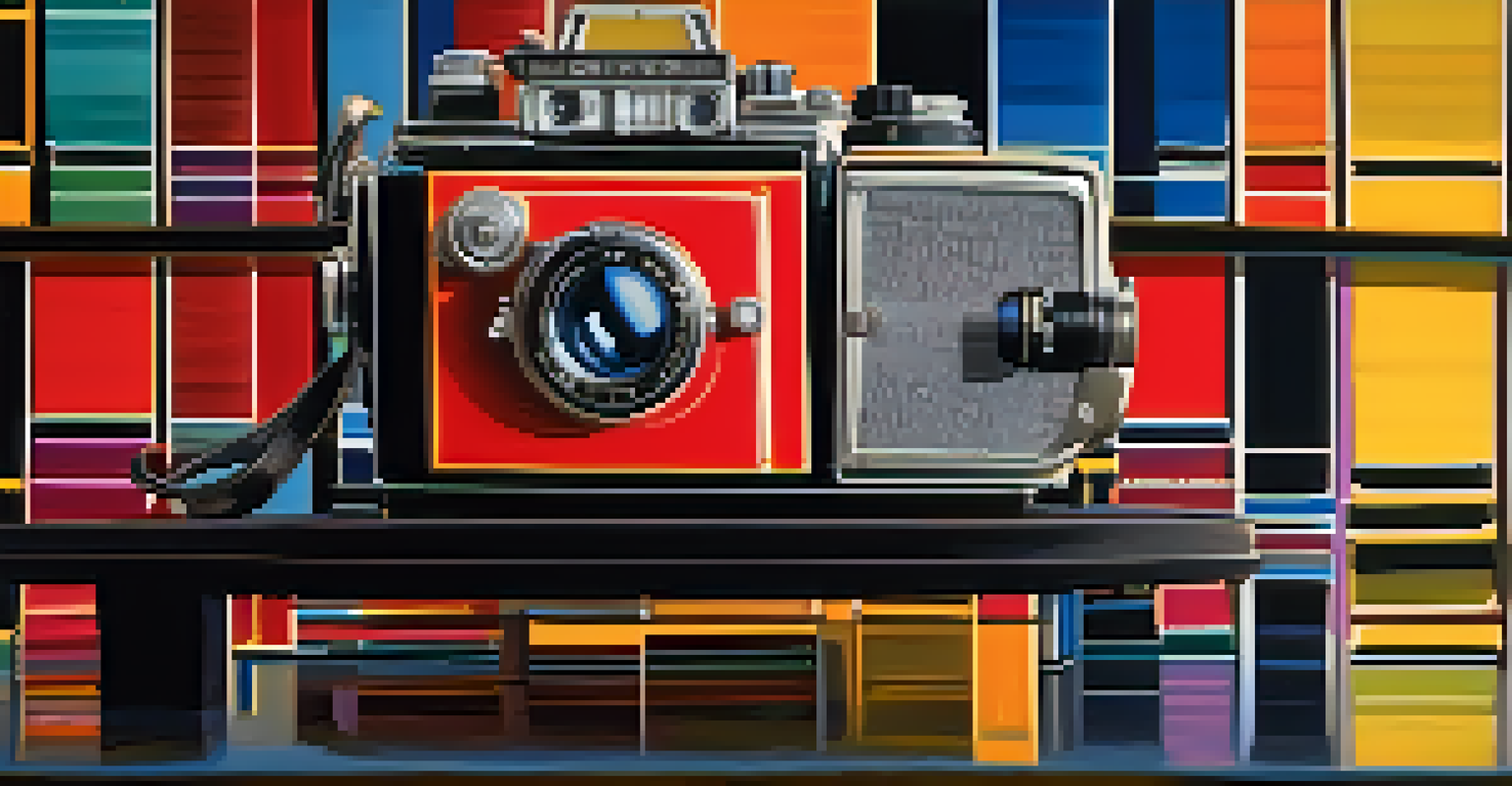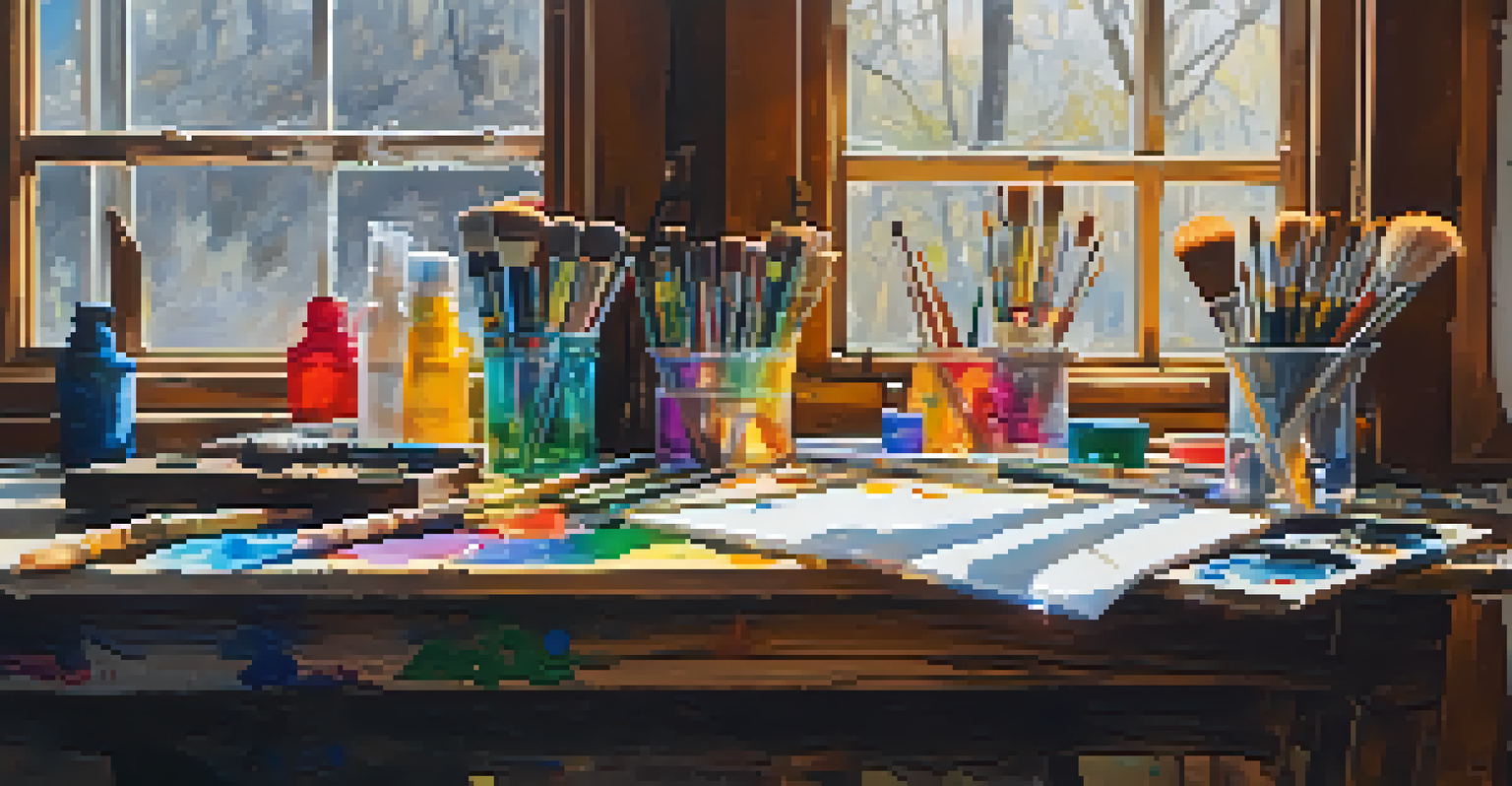Cinematic Color Grading: Tools and Software for Filmmakers

Understanding Cinematic Color Grading Basics
Cinematic color grading is the art and science of enhancing the visual quality of film. It involves adjusting colors, contrast, and brightness to create a specific mood or atmosphere. Think of it as the final coat of paint on a masterpiece, where every hue matters and contributes to the overall narrative.
Color is the keyboard, the eyes are the harmonies, the soul is the piano with many strings.
By manipulating colors, filmmakers can guide the audience's emotions and create a more immersive experience. For instance, cool tones might evoke sadness, while warm tones can inspire feelings of happiness or nostalgia. Understanding this emotional connection is vital for any filmmaker aiming to tell a compelling story.
In short, color grading transforms raw footage into a polished final product, making it a crucial step in the filmmaking process. The right tools and software can make this task easier and more effective, allowing filmmakers to focus on their creative vision.
Key Color Grading Software for Filmmakers
There are several powerful software options available for color grading, each with unique features. Adobe Premiere Pro and DaVinci Resolve are two of the most popular choices among filmmakers. While Premiere Pro offers an intuitive interface for beginners, DaVinci Resolve stands out with its advanced color correction capabilities and free version.

For those looking for a more specialized tool, Filmora and Final Cut Pro provide user-friendly interfaces with essential grading tools. They are perfect for independent filmmakers who may not require the extensive features of high-end software but still want professional results. The choice ultimately depends on your skill level and specific project needs.
Cinematic Color Grading Essentials
Color grading enhances film visuals by adjusting colors and brightness to evoke emotions and create atmosphere.
Regardless of which software you choose, understanding the fundamental color grading techniques will enhance your ability to tell stories visually. Experimenting with different software can also help you find the one that feels right for your workflow, so don’t hesitate to try a few before settling on one.
Essential Tools for Color Grading Workflow
Aside from software, having the right tools can significantly enhance your color grading workflow. A calibrated monitor is essential for accurate color representation, ensuring that what you see on screen matches the final output. Investing in a good monitor can make a noticeable difference in the grading process.
Color is the ultimate form of expression, it can change mood, evoke feelings, and enhance the storytelling experience.
Additionally, color grading panels like the DaVinci Resolve Mini Panel can streamline your workflow. These dedicated devices offer tactile controls that allow for more precise adjustments compared to using a mouse and keyboard. This can lead to a more intuitive and faster grading process as you can make adjustments on the fly.
Lastly, remember to have a reliable set of headphones or studio monitors to accurately hear the audio alongside your visuals. This holistic approach to filmmaking ensures that both color and sound work harmoniously together, making your final product more impactful.
Color Grading Techniques Every Filmmaker Should Know
When it comes to color grading, there are a few key techniques that every filmmaker should master. One essential method is color matching, which ensures that scenes shot at different times or locations have a consistent look. This creates a seamless viewing experience and maintains the film's visual integrity.
Another technique is the use of LUTs, or Look-Up Tables, which can quickly apply a specific color grade to your footage. LUTs can save time and inspire creativity, allowing you to experiment with different looks without starting from scratch. However, it's essential to adjust them based on your footage for the best results.
Key Tools for Effective Grading
Using the right software and tools, such as calibrated monitors and color grading panels, can streamline your grading workflow.
Lastly, don’t underestimate the power of secondary color correction. This technique allows you to adjust specific colors within your shot, enhancing or diminishing them as needed. By mastering these techniques, you can elevate your color grading skills and create visually stunning films.
The Importance of Color Theory in Grading
Understanding color theory is crucial for effective color grading. It provides a framework for how colors interact and influence emotions. For example, complementary colors can create contrast and draw attention, while analogous colors can create harmony and cohesion.
Using color theory can help you make strategic choices about your film’s color palette. This strategic approach can set the mood, highlight themes, and support character development. A well-thought-out color scheme can make your film not only visually appealing but also emotionally resonant.
By applying these principles, you can create a more engaging experience for your audience. So, take the time to study color theory and incorporate it into your grading process—your films will thank you for it!
Real-World Examples of Successful Color Grading
Looking at successful films can provide insight into effective color grading techniques. For instance, the film 'Mad Max: Fury Road' is renowned for its bold color palette, using contrasting colors to emphasize the chaos of its post-apocalyptic world. Such decisions elevate the storytelling and leave a lasting impression on viewers.
Another great example is 'The Grand Budapest Hotel,' where the color grading complements the film's whimsical style. The use of pastel colors not only creates a unique aesthetic but also enhances the film’s nostalgic and playful tone. Analyzing these films can inspire your own color choices and grading techniques.
Mastering Color Grading Techniques
Techniques like color matching and using LUTs are crucial for achieving a consistent and visually striking film.
By studying the work of accomplished filmmakers, you can gain a deeper understanding of how color grading contributes to storytelling. It’s a reminder that every color choice has a purpose and can significantly impact the viewer’s experience.
Future Trends in Color Grading Technology
As technology advances, the world of color grading continues to evolve. New software updates and tools are constantly improving the grading process, making it more accessible to filmmakers of all levels. For example, AI-driven tools are emerging that assist in automatic color correction, saving time and enhancing efficiency.
Additionally, trends such as virtual reality and augmented reality are shaping the future of color grading. Filmmakers are exploring how color can be used in immersive environments, creating a new set of challenges and opportunities. Embracing these trends can open up exciting possibilities for storytelling.

Staying informed about these advancements will help you remain competitive in the industry. As new technologies emerge, they will undoubtedly influence how we approach color grading, allowing for even more creativity and innovation in filmmaking.